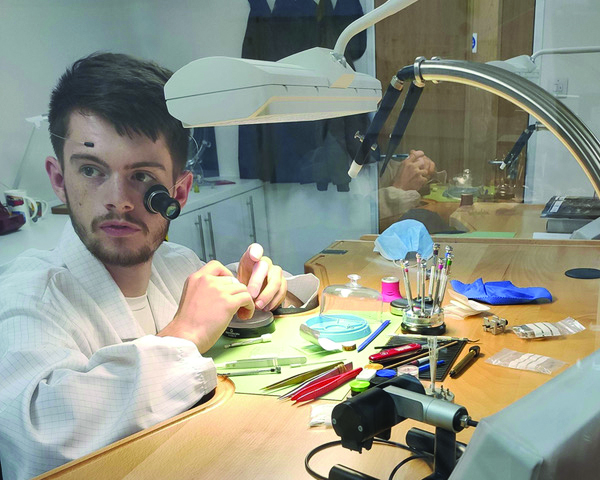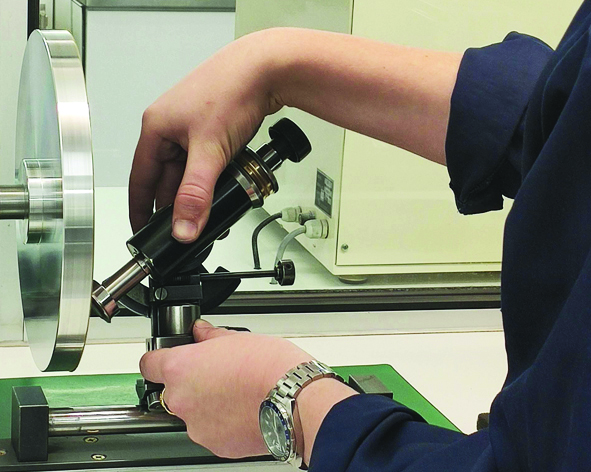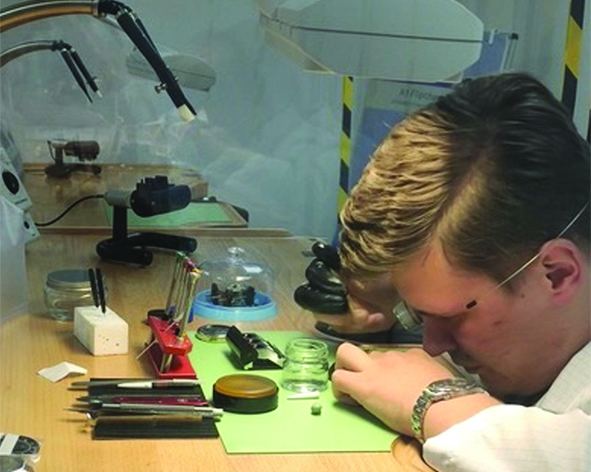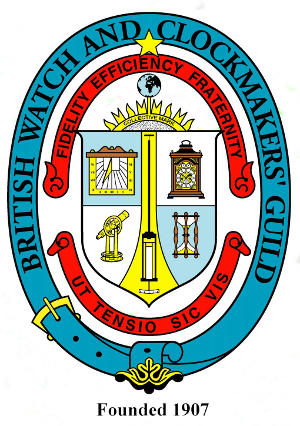Information in Timepiece helps to keep members of the Guild abreast of apprenticeship opportunities, ideal for filling that gap in the workshop. This edition reports on the latest news about the government ‘Trailblazer’ apprenticeship for watchmakers, a new initiative from the Clockmakers’ Company and ‘Kickstart’.
Background:
A shortage of watchmakers makes recruitment difficult, and companies are now busier than ever. The government will pay for 95% of the training costs for an apprentice meaning there is no better time to employ an apprentice. With the Funding Band of £27,000, the employer receives £25,650 of training and support for their apprentice from the Watchmaker Apprentice Training School for nothing, the employer contribution is just £1,350; for levy payers, there is no charge. The scheme offers small group teaching in a specialist training workshop for fourteen weeks during the two-year apprenticeship. E-learning ensures progress continues in the workplace – assignments are set on a weekly basis, marked and returned with feedback. At first, the apprentice masters ‘part jobs’, battery changing, fitting new stems and bracelets; soon, the emphasis is on servicing quartz watches and quickly progresses to manual winding watches and automatics. It is not just learning in a classroom; nearly all the teaching concentrates on practical watch servicing using commercial equipment including polishing machines to refurbish watch cases and bracelets. Employers are delighted with the training provided which helps the apprentices to quickly become an asset to their business.


here is a government initiative, which applies to the Watchmaker Apprenticeship with its January 2022 start date, but you need to be quick.
A £3,000 incentive to employ an apprentice is available but the scheme ends on 31st January 2022. Once applications open in January 2022, you will be able to apply for a payment of £3,000 for an apprentice with an employment start date from 1st October 2021 to 31st January 2022. This means that employers will receive £3000 for every new employee who starts employment, and is enrolled onto an apprenticeship with them, before the cut-off date.
Employers are responsible for making the claim, which will be paid directly by the government in two equal instalments, at 3 months and 12 months from the start date of the employee. All new employees of any ages starting any apprenticeship programme will be eligible.
A statutory review by the Institute for Apprenticeships and Technical Education (IfATE) commenced in 2019 to consider the need for the watchmaker apprenticeship in the future. It was good news when IfATE reported the apprenticeship was fulfilling the needs of the industry and should be continued. There was, however, a sting in the tail. So much had changed since the apprenticeship was originally written and the documentation required rewriting to ensure conformity with the latest standards. It sounded just a very simple task but actually took a number of months to complete. Without this, the £27,000 payment from government to train each apprentice for two years could be lost. Richemont generously supported this process which is now complete and was submitted on 8th September. Fingers crossed for approval in about two months.
One very important feature of the apprenticeship is off-the-job training. All apprentices who are part of the government scheme must receive 20% off-the-job training to ensure the apprenticeship is a genuine learning opportunity. Careful calculations were required when planning the programme to be certain the block release sessions, together with three hours e-learning each week when the apprentice is in the workplace, totalled the requisite one fifth of the hours of employment. Progress reviews and on-programme assessment are an essential ingredient of the apprenticeship and are included in the off-the-job training. A practical assessment is arranged at the start of each block release session with the objective of determining whether the skills taught previously have been maintained or if additional practice is necessary.
At the end of the apprenticeship the employer, with the apprentice and teacher at the Watchmaker Apprentice Training School, decide whether the apprentice is ready for the End-point Assessment, an independent evaluation of the apprentice’s servicing skills, knowledge and behaviours. Servicing skills, and knowledge are self-explanatory but what are the ‘behaviours’? Behaviours, mindsets, attitudes and approaches necessary for competence, were introduced with the Trailblazer approach to apprenticeships.
The apprentice is part of a team working together to undertake watch servicing for clients; for that team to function effectively, it is important for everyone to contribute safely and harmoniously without tension or disagreement. In many instances behaviours are innate or instinctive and the employer will unconsciously consider how well a new apprentice will ‘fit in’ with the workforce but behaviours can be learnt.

Examples of behaviours from the watchmaker apprenticeship include:
- Maintains a tidy working environment and replaces equipment after use.
- Promotes a positive safety culture; ensures work is carried out in a safe way that does not put themselves or others at risk.
- Listens to others and respects alternative views and opinions.
The End-point Assessment takes place over two days; the apprentice services a quartz watch, an automatic watch and polishes the case a bracelet for the automatic watch.
In addition, there is a theory test and an interview. Work is already in hand to prepare assessment materials to rigorously verify the quality of servicing, depth of knowledge and the associated behaviours.
The George Daniels Educational Trust has withdrawn from apprentice training and now concentrates on assisting students to access learning at the various colleges offering horological training. Apprenticeships, one excellent source of training, would have ceased but for the enthusiasm and vision of the Worshipful Company of Clockmakers. The Company’s Charter defined apprentice training in 1631 but much has changed since then, a new, more structured approach is required. The apprenticeship is not part of the Trailblazer scheme but nevertheless the provision is rigorous with a calendar of assignments for each apprentice. The Company provides a copy of the BHI Distance Learning Course (DLC) for each of the three years of the apprenticeship and pays for examinations and BHI membership.
sadly, too many would be horologists commence the DLC but never reach the Final Grade; skilful mentoring from the Company is set to change this. It is essential to support the apprentice and provide feedback throughout all aspects of the scheme, theory, practical servicing and the skills to construct clock components. Mentoring allows the employer to concentrate on the mastery of clock servicing and repair and releases them from the responsibility of encouraging the apprentice to study theory and prepare for the examinations. It is a well-tested formula for success.
Marking schemes are being developed to thoroughly assess and provide feedback for each step of the way. New teaching materials will enhance learning and interactive assessment reinforces the understanding of underpinning knowledge. The approach is distinctly different to that of 1631!

At the moment, there are four apprentices, two about to commence their second year. The scheme is designed to assist apprentices to gain the Diploma in the Servicing and Repair of Clocks/Watches with eligibility to become a Member of the British Horological Institute (MBHI).
Further details are available from the Clerk, clerk@clockmakers.org
3. Just as there is a Trailblazer apprenticeship for watchmakers, a Trailblazer apprenticeship has been developed for clockmakers. The documentation is complete and can be viewed on the IfATE website (Clock maker / Institute for Apprenticeships and Technical Education ) but, until a suitable End-point Assessment Organisation (EPAO) commits, in principle, to delivering the End-point Assessment, the apprenticeship will not be released for delivery. A huge amount of time must have been expended to develop the documentation for the clockmaker apprenticeship and, with funding of £21,000 to deliver the two-year apprenticeship, there is a substantial sum available to help pay for training. The problem is a lack of sufficient clockmaker apprentices to warrant the cost for the EPAO to develop assessment materials.
If you are considering employing an apprentice during the year, please let the Clerk know, it might be possible to reassure the EPAO it will be worthwhile to continue.
If you are still undecided about employing an apprentice, then ‘Kickstart’ may be for you. Nothing to with the motorcycles you sometimes see in Timepiece. The scheme has been extended to March 31st 2022; all placements must start by this date and last for 26 weeks. Kickstart placements will therefore still be active to the end of Sept 2022. The Kickstart Scheme can apply to the employment of a single apprentice. To be eligible, an employer must create a new job role for an unemployed young person aged 16-24 who is, at the time of applying, in receipt of Universal Credit and who has been put forward for the Kickstart scheme by a Job Centre Plus work coach. It must be a new role that does not replace existing employment contracts. The job role offered by the employer must offer at least 25 hours of paid work a week for six months. The employer must pay the National Minimum wage or above and the role can only involve basic training. However, for each job placement created, the employer will receive £1,500 in funding. In addition, the Scheme covers the cost of the National Minimum Wage for 25 hours per week for six months (26 weeks) for each new job placement. National Insurance Contributions and minimum automatic enrolment contributions are also funded by the scheme for each new employee.
The £1500 is to support the employer with initial costs associated with the role, as well as to provide training and employability support to the Kickstart candidate, which might include helping them find future roles, develop their employability more broadly, support them to develop their CV, learn new skills or gain improved understanding of entering the jobs market.
It is a way to add a talented young person to your workforce – without paying a penny towards their wages for six months. https://www.gov.uk/government/collections/kickstart-scheme
D J Poole FBHI
19.9.2021
